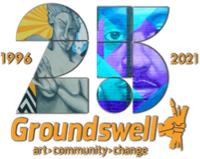
Groundswell Q&A with National Academician, Odili Donald Odita
This past summer, Groundswell youth artists participating in our Summer Leadership Institute had the opportunity to work closely with Odili Donald Odita, a National Academician – an exclusive community of artists and architects who are elected by their peers in recognition of extraordinary contributions to art and architecture in America – with the National Academy of design. The critically acclaimed abstract painter and professor of Painting, Drawing and Sculpture at the Tyler School of Art and Architecture at Temple University in Philadelphia was kind enough to sit with us and provide some insight into his influences and background.
G: Where are you from?
O: I was born in Enugu, Nigeria and was raised in the United States, primarily in Columbus, Ohio. My family moved to the United States from Nigeria due to the Civil war there called the Biafran War.
G: Did you have access to many art programs during your youth?
O: I might have had access to them if I asked for it, but I was raised in an artistic family, so art and even art supplies were accessible to me. I had access to a lot of source material at my house. I was looking at and using comic books to draw from as well as looking at art books and picture books. I mostly drew a lot with pencils, colored pencils and water color.
G: What are your preferred artistic mediums?
O: Currently, I use acrylic paint for its versatility and technicality. It is a medium open to a lot of process and experimentation. I also like to use Flasche, gouache and pencil.
G: What’s your “why?”
O: What are the essences of humanity, and what makes us do we do the things we do? This entails the construction and use and abuse of power – racism, sexism and misogyny for example. How do we define and possess space and possess meaning – for ourselves and for others?
I want to see what happens to a question when investigated. I want to see what a formation of space through drawing and color can provide as something new to see and investigate. And I want to see these things through a socio-cultural perspective.
G: Have social justice issues influenced your past works?
O: Absolutely, and in so many ways. I am moved and motivated in the pursuit of justice. There is unfairness and injustice in most things. We have to be more alert to see this in all its degrees. We can be more attentive to inequity and we have the power to address this problem directly. It is not always an easy thing to do, but the very good things in life never are easy. It only seems so once we have arrived.
G: I read that you were an art critic. What went into your critical lens? How did you formulate your critiques?
O: My criticism has always been based on my practice as a painter. It involved utilizing this experience, and along the way, I would also be learning from my questions on what I was seeing and thinking about while looking. Criticism is very much interactive in how one has to respond to what one sees and thinks about in this process of contemplation. Context is very important in this consideration. One has to be open to the many conditions and groundings the artist is providing as well as to the conditions that frame the artist, and the work one is seeing.
G: How did you go about lending that critical eye toward the work of Groundswell’s Summer Leadership Institute?
O: I wanted the students to see what their work was doing formally and functionally. I wanted them to see if closely in order to know how they could possibly make their work better. By helping them to see what they did and how they made it, they might better understand their work’s effectiveness.
G: What was your experience like working with the youth of Groundswell?
O: It was like any other critique only in that you have to cue into the students and people you are talking to. One not only has to speak, more importantly, one has to listen in critique, and hear what is being said and how. It was great to learn where everyone was coming from, and to begin to understand their ambitions
G: What advice would you give to aspiring artists?
O: Always listen to your inner voice and learn to trust what is says and how it leads you. Learn also to listen better. It is important to know that one can learn from anyone and anywhere; one will need to know what it important and what is not at the right time, and this comes from learning to listen better, more openly, and allowing yourself to be challenged with/through differences.
G: 10 years from now, where do you hope to be as an artist?
O: I hope to still be able to work actively in my studio experimenting, making and doing. There is always success in being able to accomplish each of these steps.




